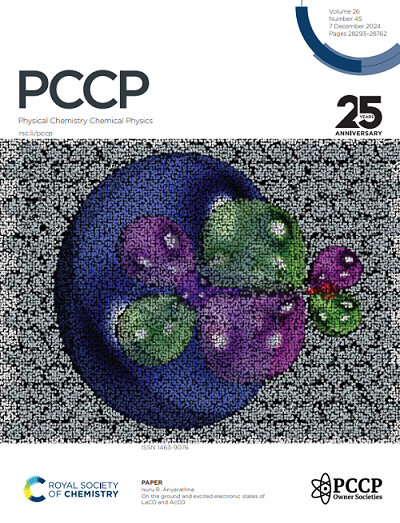Density functional calculations of diffusion paths of CH3Sad on c(2×2)-Cl and -Br covered Cu(100) surfaces
IF 2.9
3区 化学
Q3 CHEMISTRY, PHYSICAL
引用次数: 0
Abstract
Identification of the atomic-scale mechanisms of surface diffusion at interfaces covered by co-adsorbates is relevant for understanding electrochemical processes at these interfaces. The surface dynamics of CH3Sad on c(2×2)-Cl covered Cu(100) surfaces has been studied with video-STM in electrochemical environment by Yang, Taranowski, and Magnussen [Langmuir, 2012, 28, 14143]. We present density functional calculations to predict diffusion paths and energy barriers of CH3Sad substitutionally adsorbed on c(2×2)-Cl or -Br covered Cu(100) surfaces and compare them to the case of Sad. Additional vacancies in the halogen adlayer enable further diffusion paths with significantly lower DFT energy barriers (i.e. energy barriers in case of uncharged surfaces vs. vacuum). We argue that at least in case of Cl-covered surfaces this preference for vacancy-assisted diffusion of CH3Sad persists when the energy for creating a Cl-vacancy is accounted for. However, we have not yet been able to include the effect of the electric field on the computed energy barriers for this system, which might affect the preferred diffusion mechanism.CH3Sad在c(2×2)-Cl和-Br覆盖的Cu(100)表面上扩散路径的密度泛函计算
确定共吸附剂覆盖界面的原子尺度表面扩散机制对于理解这些界面的电化学过程非常重要。Yang、Taranowski 和 Magnussen 利用视频-STM 研究了电化学环境中 c(2×2)-Cl 覆盖的 Cu(100) 表面上 CH3Sad 的表面动力学[Langmuir, 2012, 28, 14143]。我们进行了密度泛函计算,预测了被 c(2×2)-Cl 或 -Br 覆盖的 Cu(100) 表面上替代吸附的 CH3Sad 的扩散路径和能障,并与 Sad 的情况进行了比较。卤素吸附层中的额外空位使得进一步扩散的路径具有明显更低的 DFT 能量势垒(即无电荷表面与真空时的能量势垒)。我们认为,如果考虑到产生 Cl- 空位的能量,至少在覆盖有 Cl 的表面上,CH3Sad 的空位辅助扩散偏好仍然存在。不过,我们尚未能将电场对该系统计算能垒的影响计算在内,而电场可能会影响优先扩散机制。
本文章由计算机程序翻译,如有差异,请以英文原文为准。
求助全文
约1分钟内获得全文
求助全文
来源期刊

Physical Chemistry Chemical Physics
化学-物理:原子、分子和化学物理
CiteScore
5.50
自引率
9.10%
发文量
2675
审稿时长
2.0 months
期刊介绍:
Physical Chemistry Chemical Physics (PCCP) is an international journal co-owned by 19 physical chemistry and physics societies from around the world. This journal publishes original, cutting-edge research in physical chemistry, chemical physics and biophysical chemistry. To be suitable for publication in PCCP, articles must include significant innovation and/or insight into physical chemistry; this is the most important criterion that reviewers and Editors will judge against when evaluating submissions.
The journal has a broad scope and welcomes contributions spanning experiment, theory, computation and data science. Topical coverage includes spectroscopy, dynamics, kinetics, statistical mechanics, thermodynamics, electrochemistry, catalysis, surface science, quantum mechanics, quantum computing and machine learning. Interdisciplinary research areas such as polymers and soft matter, materials, nanoscience, energy, surfaces/interfaces, and biophysical chemistry are welcomed if they demonstrate significant innovation and/or insight into physical chemistry. Joined experimental/theoretical studies are particularly appreciated when complementary and based on up-to-date approaches.
 求助内容:
求助内容: 应助结果提醒方式:
应助结果提醒方式:


